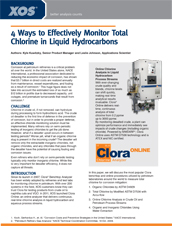- Analyzers
- Optics & Sources
- Technologies
- Support
- About
4 Ways to Effectively Monitor Total Chlorine in Liquid Hydrocarbons

Chlorine in crude oil, if not removed, can hydrolyze during processing to form hydrochloric acid. The crude oil desalter is the first line of defense in the prevention of corrosion, but in order to provide a proper defense, an effective chloride monitoring solution must be implemented. Many refiners rely on semi-periodic testing of inorganic chlorides to get the job done. However, what if a desalter upset occurs in between testing periods? Worse yet, what if an organic chlorine slug is present in the incoming crude? The desalter will remove only the extractable inorganic chlorides, not organic chlorides, and any chlorides that pass through the desalter have the potential of causing fouling and corrosion issues. Even refiners who don’t rely on semi-periodic testing typically only monitor inorganic chlorine. While this is very important for desalter efficiency, it does not capture all threats.
Download our whitepaper to learn more about four ways to effectively monitor total chlorine.

